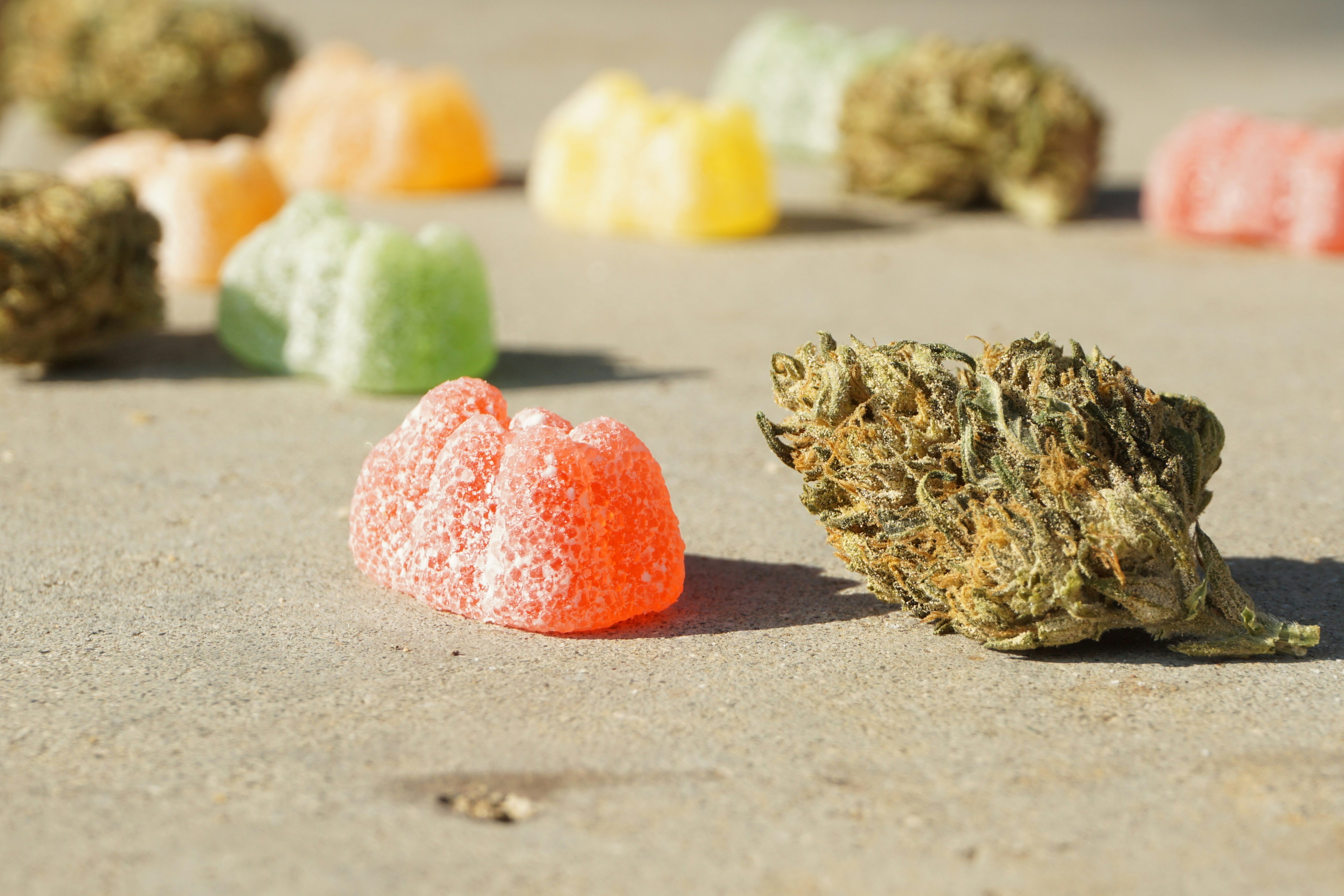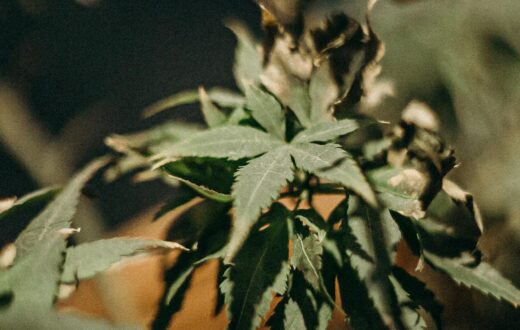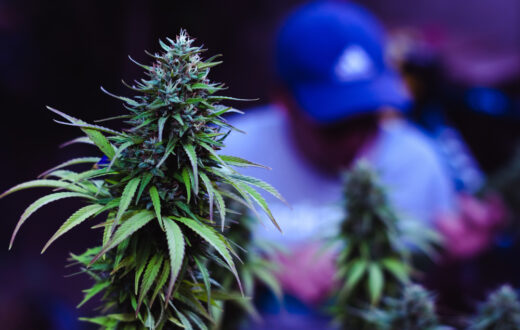Introduction to Candyland CBD Strain
The Candyland CBD strain has garnered significant attention in the cannabis community, particularly for its unique genetic lineage and distinctive characteristics. A hybrid strain that leans toward a more sativa-dominant profile, it is a crossbreed of the well-known Granddaddy Purple and a phenotype of the Bay Platinum Cookies. This combination not only contributes to its robust potency but also enhances its visual appeal and aroma. The Candyland CBD strain exhibits vibrant green foliage with shades of purple, and its flowers are often adorned with glistening trichomes, making them particularly attractive for growers and users alike.
One of the primary reasons for the growing popularity of the Candyland CBD strain is its rich terpene profile, which includes hints of sweet candy, citrus, and pine. This aromatic combination leaves a pleasant aftertaste, which appeals to a broad spectrum of cannabis connoisseurs. Importantly, the strain offers an impressive balance of THC and CBD content, providing users with an uplifting and euphoric experience without overwhelming psychoactive effects. This makes it an excellent choice for those seeking a more balanced consumption experience, particularly when looking for therapeutic applications.
In addition to its appealing flavor and aroma, the Candyland CBD strain boasts various medicinal benefits. Users have reported relief from anxiety, stress, and chronic pain, making it a suitable option for those seeking natural solutions for their ailments. The low levels of THC, combined with higher concentrations of CBD, facilitate various therapeutic effects, all while allowing individuals to maintain clarity and focus. As cannabis cultivation continues to evolve, understanding how to grow Candyland CBD strain becomes increasingly valuable for both personal and commercial growers, ensuring that they can tap into its full potential for both recreation and medicinal use.
Understanding the Growing Requirements
To successfully cultivate the Candyland CBD strain, it is vital to understand its specific growing requirements. These include optimal light conditions, temperature, humidity, and soil type, all of which play a significant role in ensuring healthy plant development and maximizing yield.
Light is one of the most critical factors when growing this strain. Candyland CBD strain thrives in environments that provide at least 18 hours of light during the vegetative stage. In indoor setups, high-quality LED or HID lights are recommended to offer the intensity necessary for flourishing growth. For outdoor cultivation, selecting a location that receives full sun exposure is pivotal, as this strain favors warm, sunny environments.
Temperature also significantly impacts the growth of the Candyland strain. Ideally, daytime temperatures should range between 70°F and 80°F (21°C to 27°C), while nighttime temperatures should not fall below 60°F (15°C). Maintaining these temperatures helps prevent stress on the plants, which can lead to lower yields and suboptimal quality.
Humidity levels should be carefully monitored throughout the growth cycle. During the vegetative phase, maintaining humidity between 40% and 60% is recommended, while in the flowering stage, a decrease to about 40% will help prevent mold and mildew. Proper ventilation is equally important to manage humidity levels effectively.
The soil type is another essential consideration when learning how to grow Candyland CBD strain. Well-draining soil enriched with organic matter is ideal; a pH range of 6.0 to 7.0 will facilitate optimal nutrient absorption. Many growers prefer to use a mix of coco coir and perlite to achieve the necessary drainage and aeration.
In terms of cultivation methods, whether you choose to grow indoors, outdoors, or within a greenhouse, each approach has its advantages. Indoor growing allows for more control over environmental variables, while outdoor cultivation can yield larger plants. Greenhouses provide a balance of these benefits, protecting plants from pests while allowing natural sunlight to nourish them. By considering these requirements, growers can enhance their chances of effectively growing the Candyland CBD strain.
Seed Selection and Germination Techniques
Choosing the right seeds for cultivating the Candyland CBD strain is a critical first step to successful growth. Seed genetics play a significant role in determining the quality and potency of the plants produced. Select seeds from reputable breeders or trusted suppliers that specialize in cannabis cultivation. Look for seeds that are feminized to ensure a higher yield of female plants, which are essential for producing the desired CBD-rich buds. Additionally, consider organic seed options, as they can contribute to a healthier growing environment with fewer harmful chemicals.
Once you have acquired the seeds, the germination process is essential for achieving a successful crop. One effective technique is soaking the seeds in water for 24 hours prior to planting. This process helps to soften the seed coat and promotes faster sprouting. Following soaking, place the seeds in a damp paper towel, and keep them in a warm and dark location. This method creates the ideal microenvironment for germination to occur.
An alternative approach involves using a dedicated germination station or seed starter kit. These kits generally provide a controlled environment with optimal moisture and temperature levels, which significantly boost germination rates. Ensure that the medium used is sterile and well-aerated to facilitate root oxygenation and prevent damping-off, a common problem among seedlings. When the seeds develop a small taproot, it is time to carefully transplant them into growing containers filled with a nutrient-rich soil mix.
Implementing these seed selection and germination techniques not only enhances your knowledge of how to grow the Candyland CBD strain but also lays the groundwork for a thriving crop. By taking the time to ensure optimal seed selection and proper germination, you are setting yourself up for a successful gardening experience.
Nutrient Regimen and Watering Guidelines
Understanding how to grow Candyland CBD strain effectively involves an emphasis on the right nutrient regimen and watering techniques. This cannabis strain flourishes when nurtured with a balanced supply of macronutrients and micronutrients. Essential macronutrients such as nitrogen, phosphorus, and potassium should be applied during all growth stages but in varying proportions. In the vegetative stage, a higher ratio of nitrogen is beneficial to support leaf development, while during the flowering phase, an increased phosphorus and potassium level will enhance bud formation and resin production.
In addition to the base nutrients, supplementing with calcium and magnesium can further promote healthy growth and flowering. Utilizing organic nutrients such as compost teas or liquid worm castings can enrich the soil and provide a slow-release of vital nutrients, which is particularly beneficial for the Candyland CBD strain. Implementing a feeding schedule approximately every two weeks and adjusting as needed based on the plant’s growth stage will help maintain optimal nutrient levels.
Watering the Candyland CBD strain appropriately is equally crucial. This strain prefers a consistent watering routine, avoiding both overwatering and underwatering. Monitoring the soil moisture is essential; a good practice is to check the top inch of the soil. If it feels dry, it is time to water. Conversely, if the soil feels consistently wet, this may indicate overwatering, which can lead to root rot and stunted growth. During the early growth stages, daily checks are recommended, transitioning to less frequent watering as the plant matures.
To summarize, achieving success with how to grow Candyland CBD strain greatly relies on implementing a tailored nutrient regimen and adhering to structured watering guidelines. By understanding the nutritional needs and water requirements throughout the plant’s growth stages, cultivators can ensure robust growth and a potent yield.
Pest and Disease Management
Effective pest and disease management is a crucial aspect of cultivating the Candyland CBD strain. As this strain is known for its aromatic and flavorful buds, it can attract a variety of pests that may threaten its health and yield. Common pests that affect Candyland include aphids, spider mites, and whiteflies, each of which can significantly hinder the growth and potency of the plants.
To prevent infestations, growers should adopt integrated pest management (IPM) strategies. This includes regular monitoring of plants for early signs of pests. Inspecting the undersides of leaves and the surrounding soil can help identify issues before they escalate. Achieving healthy soil through organic amendments can also create a strong foundation for resilient plants, increasing their ability to withstand pest attacks.
In addition to prevention, maintaining proper environmental conditions plays a significant role in the overall health of the Candyland CBD strain, as pests often thrive in stressful situations. Ensure adequate air circulation and controlled humidity levels to deter pests. Utilize companion planting by incorporating herbs such as basil or garlic, which can naturally repel harmful insects.
When it comes to treating infestations, organic solutions are often preferred, particularly for those focusing on the cultivation of high-quality CBD. Insecticidal soaps and neem oil are effective options that can reduce pest populations without harmful effects on the plants. For disease management, keep an eye out for symptoms of common fungal infections, such as powdery mildew. Utilizing fungicides with organic ingredients can help treat these diseases while safeguarding the integrity of the Candyland CBD strain.
Ultimately, diligent monitoring and proactive measures will equip growers with the tools needed to manage pests and diseases effectively. By understanding how to grow Candyland CBD strain while ensuring its protection, cultivators can enjoy a healthy and bountiful harvest.
Pruning and Training Techniques
Effective management of the Candyland CBD strain is crucial for maximizing both growth and yield. Pruning and training techniques play an essential role in achieving optimum results. Among the most prevalent methods are topping, fimming, and low-stress training (LST). Each technique comes with its specific advantages and should be employed thoughtfully based on the goals of the grower.
Topping involves cutting off the top of the main stem. This encourages the plant to develop multiple colas instead of focusing energy on a single point. As a result, the plant becomes bushier and can ultimately yield a higher quantity of buds. When learning how to grow Candyland CBD strain, it is advisable to top the plant when it reaches about six nodes. Following this procedure not only enhances the morphology of the plant but also ensures that light can penetrate deeper, fostering symmetrical growth across all branches.
Fimming, a variation of topping, entails removing just a portion of the plant’s growth tip. This method also stimulates the growth of multiple colas but does so by causing a lesser degree of stress. Growers may prefer fimming when aiming for a faster recovery time while still promoting a bushy structure. It is especially beneficial when cultivating the Candyland CBD strain, allowing for a more resilient plant that can withstand various environmental factors.
Low-stress training (LST) is a technique that bends and ties down branches to promote horizontal growth. This method ensures an even canopy and maximizes light distribution, essential for photosynthesis. By implementing LST during the vegetative stage of the Candyland CBD strain, growers can maintain better control over plant height and manage space efficiently in indoor settings. Proper scheduling and technique practice can significantly enhance the overall quality and quantity of the yield.
Harvesting Tips for Maximum Yield
Harvesting is a critical phase in the cultivation process of the Candyland CBD strain. To achieve maximum yield and optimal potency, it is essential to determine the appropriate time for harvesting. One of the most reliable indicators of readiness is the trichome development. As the buds mature, trichomes transition from clear to milky white, indicating peak potency, and eventually to an amber hue, which signifies potential over-ripeness. Ideally, a balance of milky and a few amber trichomes will result in a well-rounded flavor and effect.
Additionally, the color of the pistils can further assist in deciding the right moment for harvesting. When approximately 70-80% of the pistils have darkened and curled inwards, it generally indicates that the Candyland CBD strain is ready to be harvested. Observing these signs closely can help maximize your yield and overall quality.
Once the right harvesting time is determined, the cutting technique becomes important. It is advisable to cut the branches at the base of the plant, utilizing clean, sharp scissors or shears to minimize damage to the remaining plant. This will ensure that any unharvested clusters continue to grow optimally, providing a potential second yield. After the branches have been cut, the trimming process begins. Removing excess leaves from the buds is essential to improving airflow during the drying process, which helps to prevent mold and preserve quality.
After trimming, the drying stage commences. Hanging the buds upside down in a dark, ventilated space with controlled humidity levels can significantly enhance the final product’s flavor and potency. It typically takes about one to two weeks for the buds to dry adequately, but checking them frequently for moisture can prevent any unwanted surprises. Following these guidelines on how to grow Candyland CBD strain effectively can lead to a successful harvest with maximum yield and premium quality.
Curing and Storing Your Yield
Curing is an essential process following the harvest of the Candyland CBD strain, significantly influencing the flavor, aroma, and potency of the final product. This phase entails the careful drying and subsequent storing of the harvested buds, allowing for the breakdown of chlorophyll and enhancement of cannabinoids. A proper curing process contributes to the smoothness of the smoke and enhances the overall experience for the user. To effectively cure Candyland, one should begin with drying the buds in a controlled environment where temperature and humidity can be monitored. The ideal conditions usually involve a temperature of around 60 to 70 degrees Fahrenheit and humidity levels of 45 to 55 percent.
After the initial drying period, which could last from several days to two weeks, the buds should be placed in air-tight containers. This allows for the retention of moisture while promoting enzymatic action essential for further development of flavors. It is pivotal to periodically open the containers, a practice referred to as ‘burping,’ to release built-up moisture and allow fresh air in. This can take place once or twice a day for the first week and can be reduced thereafter as the buds reach the desired taste and aroma.
Once you have mastered how to grow Candyland CBD strain, understanding appropriate storage methods is crucial for maintaining quality and effectiveness. Utilizing glass jars is highly recommended, as they are excellent for preserving the potency and aroma of your yield. Keep these jars in a cool, dark area to prevent light degradation. Additionally, avoid using plastic bags or containers for long-term storage, as these can lead to moisture build-up and potential mold growth. Always prioritize careful handling during both curing and storage to ensure that the premium quality of your Candyland CBD strain is sustained for optimal enjoyment.
Conclusion and Final Thoughts
In this blog post, we have explored the essential aspects of how to grow Candyland CBD strain, focusing on its unique characteristics, growth requirements, and cultivation techniques. This strain, renowned for its soothing effects and colorful appearance, can be a rewarding endeavor for both novice and experienced growers. Proper attention to factors such as light, temperature, and nutrients is crucial for achieving optimal yields and ensuring a successful growing experience.
As we discussed, starting with quality seeds or clones can set the foundation for a successful cultivation journey. The Candyland CBD strain thrives in a controlled environment, favoring a balanced light cycle and humidity levels that reflect its natural habitat. By meticulously monitoring these conditions, growers can enhance their plants’ potential and foster a healthier growing environment. The use of organic fertilizers can further improve the flavor and potency of the yield, making the final product more appealing and enjoyable.
It is also important to remember that every grower’s experience may vary based on personal techniques and environmental factors. Continuous learning and adaptation will ultimately lead to more successful results. Experimenting with different methods and tracking outcomes can be a valuable process that not only hones your skills but also increases your understanding of the Candyland CBD strain. The unique traits of this strain provide ample opportunities for customization and innovation.
As you embark on your journey of cultivating Candyland CBD, take the insights and methods shared in this article to heart. Growing this strain can be a fulfilling experience, allowing you to witness the transformation from seed to harvest. Embrace the challenges and successes that come with it, and continue pushing the boundaries of your growing knowledge. With dedication and practice, you will pave the way to not only master how to grow Candyland CBD strain but also to relish in the fruits of your labor.












